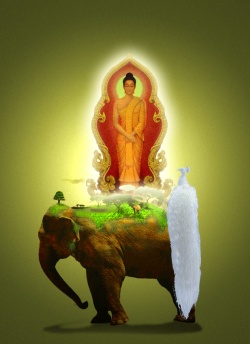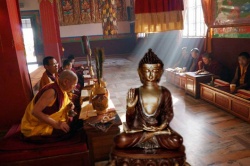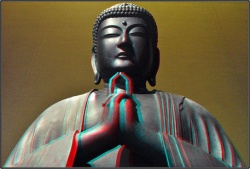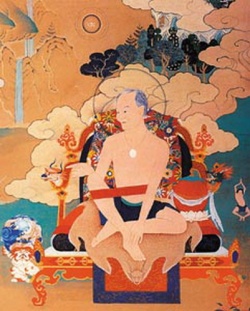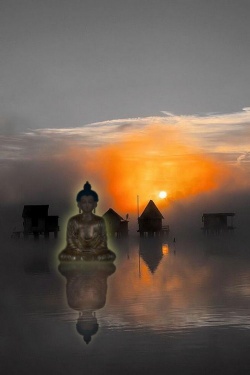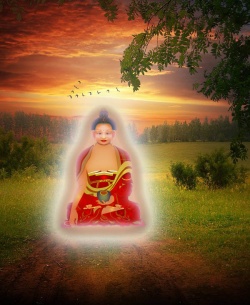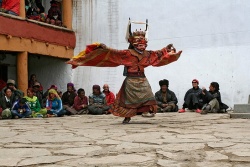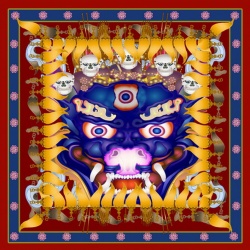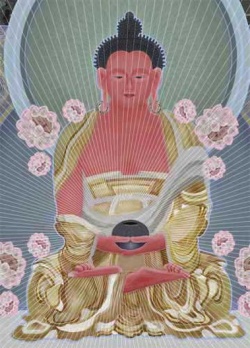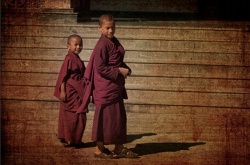Tantric Wrathful Deities: The Psychology and Extraordinary Power of Enlightened Beings in Their Fearsome Form
Tantric Wrathful Deities: The Psychology and Extraordinary Power of Enlightened Beings in Their Fearsome Form
Wrathful deities in Buddhism can be terrifying, monstrous, and demonic in appearance—but they are actually the “good guys.”
People who might be casually interested in Buddhism are often puzzled, even horrified, by Tantric Buddhist Deities depicted as ferocious personas.
At first exposure, they might seem almost demonic, sporting garlands of human heads, multiple terrifying faces, often stepping on human forms.
When Westerner’s first explored Tibet, they reported that Tibetans “worshiped demons.”
What else could they make of apparently horrifying forms more terrible than the demons of Biblical hell itself?
“Westerners can find the wrathful images bizarre and confusing,” writes psychologist Rob Preece in The Psychology of Buddhist Tantra.
“Early encounters with Tibetan culture, with its ferocious and erotic deities, led its religion to be viewed with great suspicion. Those of missionary disposition even tried to convert the Tibetans… to save them from what they saw as demon worship.”
At the same time, there is no denying the “extraordinary power of tantric deity images,” Preece added.
In fact, these forms are deliberately more terrible than demons; they represent forces that help us transform these very demons—whether you see them as psychological shadows of the mind, or tangible entities.
From a Buddhist point-of-view, they help us remove the obstacles to Enlightenment.
Writes Preece, from a psychological point-of-view, “beneath the pageantry lies a profound meaning.
It’s difficult to comprehend at first, but in our search for a way to understand the transformation of the many facets of the Shadow, Tantra can be of great significance.”
Schwarzenegger as a Wrathful Deity?
He clarifies wrathful practice with an amusing Western ‘Hell’s Angels’ example, and comparing peaceful meditations (the pinstripe-suited man) and wrathful practices (Schwarzenegger): “If we think of a gang of Hell’s Angels that has become totally wild and anarchic, how might their energy be brought under control?
If a man dressed in a pinstriped suit with good intentions said to them, ‘Now look, you fellows, this just won’t do,’ we can imagine how predictably derisory their response would be.
On the other hand, if they were addressed by a Schwarzenegger-like figure, who looked powerful and tough, dressed like a wild man, disheveled and scarred, carrying chains, knives and other weapons, the response would be different.
They might develop respect or interest and be drawn into some kind of relationship, even to the point where, becoming their leader, he could change the direction of their behavior… and their aggression would be gradually channeled.”
Wrathful deities, like the fictional Schwarzenegger character, embody wrathful characteristics.
They can appear in apparently demonic aspects, bristling with weapons, fanged, dripping blood, and surrounded by aureole’s of fire. When a serious practitioner evokes them, their power to transform is forceful and certainly very tangible.
Just as Schwarzenegger-like character puts on a show of force and ferocity, to accomplish his ‘tough love’ agenda, the Wrathful Deities of Tantra are motivated by compassion. Their cause is Bodhichitta. The wrathful appearance is an expression of skillful means.
The Embodiment of the Shadow
The non-psychologist tantric practitioner understands these wrathful deities, in part, to be the very embodiment of the negative karmas or emotions they help us confront and control.
These protector deities help us remove obstacles of our practice.
For example, bull-headed Yamantaka, the “slayer of death”, is arguably the most ferocious of the wrathful deities and is considered a helpful practice for people with anger or hatred issues.
At a higher level, Yamantaka—which means literally “slayer of death”—is a form is more terrifying than death itself, and by virtue of this he represents the very power of Enlightenment to defeat death.
Even Avalokitesvara, the peaceful and wonderful Buddha of Compassion, has his terrible form, Mahakala the great black one, as described by Vessantara:
“With a world-shaking cry the figure, now blue black, starts to its feet…
The giant figure pounds forward, wild hair streaming upward, tied around with snakes.
The massive body, nearly naked, girt only in a tiger-skin, wears skulls—pretty, staring skulls—as jewels. Snake-enwreathed, fang-mouthed, three eyes glaring bloodshot from an awesome face, he marches onward bellowing challenge…”
Dharmapalas Protect the Mind
Why would anyone wish to conjure up such apparently horrible images of Enlightenment? Vessantara explains: “On a deeper level, dharmapalas throw back into the shadows the forces of nightmare and madness which always threaten to tear loose and subjugate the human psyche.”
Interestingly, many psychologists, Preece among them, have analyzed wrathful practice and found it psychologically sound.
In the same way a psychiatrist might ask a patient to face his past traumas—often deeply buried in the subconscious—the Tantra practitioner faces the obstacles to Enlightenment.
The highly advanced practices of Tantra actually “transform” the negatives, instead of suppressing them.
“We have lost the symbols and rites of transformation that elevate the dark angel from an unconscious, potentially demonic state into a healthy conscious relationship,” writes Preece.
“Despite our best efforts at curbing and containing aberrant human nature, the daily news is filled with its shadowy effects. The question still stands as to how we transform rather than supress its forces.”
Stated another way, the purpose of wrathful deity practice is none other than converting our negative karmas and emotions into a force for Enlightenment, helping us understand Emptiness.
Or, more traditionally stated, removing the obstacles in our practice, whether external or internal.
Preece writes, “As a manifestation of the wisdom of dharmakaya, he embodies the power of wisdom to overcome the Shadow’s demonic side, not by repression, but by absorbing its forces into his nature.”
Wrathful Deities Are Usually Higher Tantric Practices
Wrathful deities are usually restricted practices for senior practitioners, often practices of the Highest Yoga Tantra.
Because we work with the darkest internal and external forces, unguided practice could be considered dangerous and is actively discouraged. A qualified teacher with lineage is always required.
The Wrathful deities can be of two main types:
These can be subdivided into three types:
Dharmapalas, or “protectors of the Dharma”; Lokapala’s who are the protectors of the world; Ksetrapalas, protectors of a region.
Dharmapalas: Protectors of Dharma
There are eight main Darmapalas, the protectors of the Dharma, who help practitioners remove the obstacles to their practice, advancing them in their cause for Enlightenment.
Yamantaka is probably the best known, and possibly the most ferocious; he is the bull-headed wrathful deity who overcame death itself. Yamantaka, an aspect of Manjusri, even ‘recruited’ Death, in the form of Yama, as a Dharmapala—demonstrating the psychologically profound principle of absorption of shadow.
Other great Dharmapalas include Mahakala, the Great Black One (an aspect of Avalokitesvara), Hayagriva, and the terrifying Goddess Palden Lhama.
Wrathful Deities: Vivid, Intense and a Heavy Commitment
Meditating on the ferocious embodiments of Enlightenment, for some people, myself included, can feel more vivid, in some ways more engaging and compelling than calming, peaceful deity meditations.
There is no question you are working with the mind. The images jump vividly, snap to clarity. Perhaps it’s the massive scale of the imagery, so intense and fierce that makes it easier to visualize for some people.
It’s neither for the faint of heart, nor the lazy of practice.
Most wrathful practices are of the highest yoga tantra class.
Tashi Tsering, in the book Tantra: The Foundation of Buddhist Thought explains: “Different vajra masters give different commitments when they give initiations—such as doing the full sadhana every day—and while this may not be the determining factor, you should consider whether you have the time and energy to follow such a practice.
Perhaps a wrathful highest yoga tantra deity with many arms and faces is attractive to you, but is that the best practice for you to do?”
Although the actual practices and visualizations are passed teacher to student, together with all-important instructions, a quick study of any of the many famous tangkhas of fierce deities, reveals an intensity of images that make’s the middle earth world of Tolkien’s Lord of the Rings seem tame.
Yet, this isn’t an exercise in fantasy, or a dream-filled trip to a wondrous mindscape. The practice of wrathful deities is difficult, rewarding and a extremely advanced. It is also not for everyone. Most wrathful practices are the highest yoga tantra class, typically only introduced to practitioners after many years of successful foundation practices.
Highest Yoga Tantra
The colorful concepts of wrathful practice can be alluring, and the promise of removing obstacles to practice is irresistible to many serious practitioners.
Beyond the immediate goal of removing obstacles, and transforming emotions and aggregates, wrathful practices—at least those of the Highest Yoga Tantra class—profoundly work on our body and mind.
As explained by Geshe Tashi Tsering, “The main objective of highest yoga tantra is to move the subtle winds or energies through the central channel to eventually enter the heart chakra and abide there.
When all of the subtle winds are dissolved into the indestructible drop at the heart chakra, we experience the clear light mind. When the clear-light mind eventually comes into union with the illusory body, the resultant state—enlightenment—is achieved.”
Wrathful and Highest Yoga Tantra are obviously not an overnight practice, nor one that can be undertaken without a teacher, yet it is still considered the “lightning path” to Enlightenment.
By harnessing fierce aspects of Enlightenment, for those who are suited karmically and emotionally to the practitioner, progress can be very fast in relative terms—although, only under the guidance of a qualified guru.
For those karmically blessed enough to find their perfect teacher, and willing to make an unbreakable commitment, the lightning path of wrathful deity practice is an extraordinarily rewarding and enlightening experience.
NOTES
- The Psychology of Buddhist Tantra, Rob Preece, Snow Lion, ISBN-13 978-15559392631.
- Commonly used psychology term referring to Shadow of the mind, the subjugated darker feelings we are ashamed of that unconsciously effect us.
- A Guide to the Deities of the Tantra by Vessantara, Windhorse Publications,
- Tantra: The Foundation of Buddhist Thought, Volume 6, Gesh Tashi Tsering.
